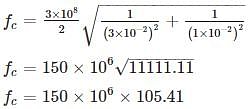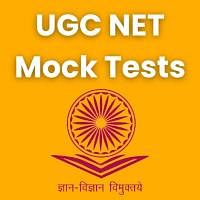UGC NET Exam > UGC NET Questions > A rectangle waveguide of internal dimensions ...
Start Learning for Free
A rectangle waveguide of internal dimensions (a = 3 cm and b = 1 cm) is to be operated at TE11 mode. The minimum operating frequency is:
- a)6.25 GHz
- b)10.5 GHz
- c)31.6 GHz
- d)15.8 GHz
Correct answer is option 'D'. Can you explain this answer?
| FREE This question is part of | Download PDF Attempt this Test |
Most Upvoted Answer
A rectangle waveguide of internal dimensions (a = 3 cm and b = 1 cm) i...
Concept:
Minimum operating frequency or the cut off frequency for a rectangular waveguide is given by:

a = length of the waveguide
b = height of the waveguide
m,n = modes of operation
Calculation:
Given, a = 3 cm
b = 1 cm
The minimum frequency in TE11 is nothing but the cut-off frequency calculated as:

fC = 15.81 GHz
Minimum operating frequency or the cut off frequency for a rectangular waveguide is given by:

a = length of the waveguide
b = height of the waveguide
m,n = modes of operation
Calculation:
Given, a = 3 cm
b = 1 cm
The minimum frequency in TE11 is nothing but the cut-off frequency calculated as:

fC = 15.81 GHz
Attention UGC NET Students!
To make sure you are not studying endlessly, EduRev has designed UGC NET study material, with Structured Courses, Videos, & Test Series. Plus get personalized analysis, doubt solving and improvement plans to achieve a great score in UGC NET.

|
Explore Courses for UGC NET exam
|

|
Similar UGC NET Doubts
A rectangle waveguide of internal dimensions (a = 3 cm and b = 1 cm) is to be operated at TE11mode. The minimum operating frequency is:a)6.25 GHzb)10.5 GHzc)31.6 GHzd)15.8 GHzCorrect answer is option 'D'. Can you explain this answer?
Question Description
A rectangle waveguide of internal dimensions (a = 3 cm and b = 1 cm) is to be operated at TE11mode. The minimum operating frequency is:a)6.25 GHzb)10.5 GHzc)31.6 GHzd)15.8 GHzCorrect answer is option 'D'. Can you explain this answer? for UGC NET 2024 is part of UGC NET preparation. The Question and answers have been prepared according to the UGC NET exam syllabus. Information about A rectangle waveguide of internal dimensions (a = 3 cm and b = 1 cm) is to be operated at TE11mode. The minimum operating frequency is:a)6.25 GHzb)10.5 GHzc)31.6 GHzd)15.8 GHzCorrect answer is option 'D'. Can you explain this answer? covers all topics & solutions for UGC NET 2024 Exam. Find important definitions, questions, meanings, examples, exercises and tests below for A rectangle waveguide of internal dimensions (a = 3 cm and b = 1 cm) is to be operated at TE11mode. The minimum operating frequency is:a)6.25 GHzb)10.5 GHzc)31.6 GHzd)15.8 GHzCorrect answer is option 'D'. Can you explain this answer?.
A rectangle waveguide of internal dimensions (a = 3 cm and b = 1 cm) is to be operated at TE11mode. The minimum operating frequency is:a)6.25 GHzb)10.5 GHzc)31.6 GHzd)15.8 GHzCorrect answer is option 'D'. Can you explain this answer? for UGC NET 2024 is part of UGC NET preparation. The Question and answers have been prepared according to the UGC NET exam syllabus. Information about A rectangle waveguide of internal dimensions (a = 3 cm and b = 1 cm) is to be operated at TE11mode. The minimum operating frequency is:a)6.25 GHzb)10.5 GHzc)31.6 GHzd)15.8 GHzCorrect answer is option 'D'. Can you explain this answer? covers all topics & solutions for UGC NET 2024 Exam. Find important definitions, questions, meanings, examples, exercises and tests below for A rectangle waveguide of internal dimensions (a = 3 cm and b = 1 cm) is to be operated at TE11mode. The minimum operating frequency is:a)6.25 GHzb)10.5 GHzc)31.6 GHzd)15.8 GHzCorrect answer is option 'D'. Can you explain this answer?.
Solutions for A rectangle waveguide of internal dimensions (a = 3 cm and b = 1 cm) is to be operated at TE11mode. The minimum operating frequency is:a)6.25 GHzb)10.5 GHzc)31.6 GHzd)15.8 GHzCorrect answer is option 'D'. Can you explain this answer? in English & in Hindi are available as part of our courses for UGC NET.
Download more important topics, notes, lectures and mock test series for UGC NET Exam by signing up for free.
Here you can find the meaning of A rectangle waveguide of internal dimensions (a = 3 cm and b = 1 cm) is to be operated at TE11mode. The minimum operating frequency is:a)6.25 GHzb)10.5 GHzc)31.6 GHzd)15.8 GHzCorrect answer is option 'D'. Can you explain this answer? defined & explained in the simplest way possible. Besides giving the explanation of
A rectangle waveguide of internal dimensions (a = 3 cm and b = 1 cm) is to be operated at TE11mode. The minimum operating frequency is:a)6.25 GHzb)10.5 GHzc)31.6 GHzd)15.8 GHzCorrect answer is option 'D'. Can you explain this answer?, a detailed solution for A rectangle waveguide of internal dimensions (a = 3 cm and b = 1 cm) is to be operated at TE11mode. The minimum operating frequency is:a)6.25 GHzb)10.5 GHzc)31.6 GHzd)15.8 GHzCorrect answer is option 'D'. Can you explain this answer? has been provided alongside types of A rectangle waveguide of internal dimensions (a = 3 cm and b = 1 cm) is to be operated at TE11mode. The minimum operating frequency is:a)6.25 GHzb)10.5 GHzc)31.6 GHzd)15.8 GHzCorrect answer is option 'D'. Can you explain this answer? theory, EduRev gives you an
ample number of questions to practice A rectangle waveguide of internal dimensions (a = 3 cm and b = 1 cm) is to be operated at TE11mode. The minimum operating frequency is:a)6.25 GHzb)10.5 GHzc)31.6 GHzd)15.8 GHzCorrect answer is option 'D'. Can you explain this answer? tests, examples and also practice UGC NET tests.

|
Explore Courses for UGC NET exam
|

|
Suggested Free Tests
Signup for Free!
Signup to see your scores go up within 7 days! Learn & Practice with 1000+ FREE Notes, Videos & Tests.
























